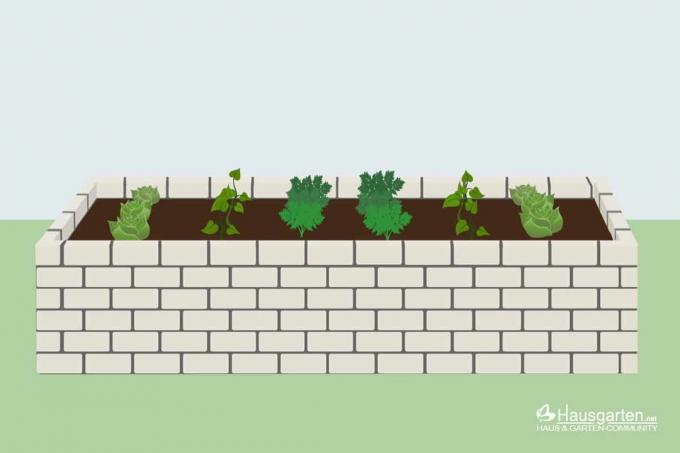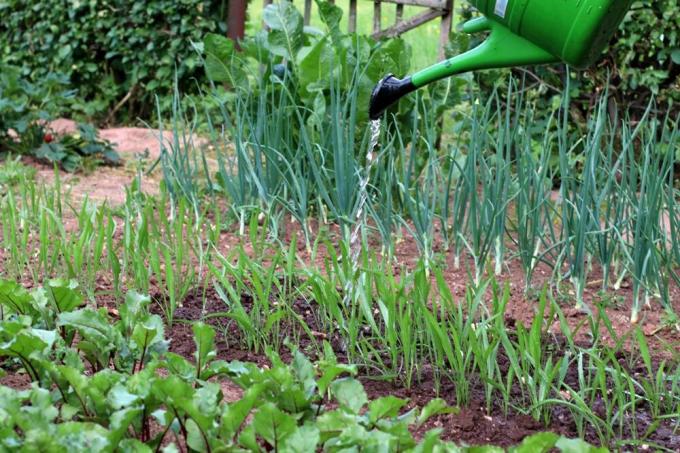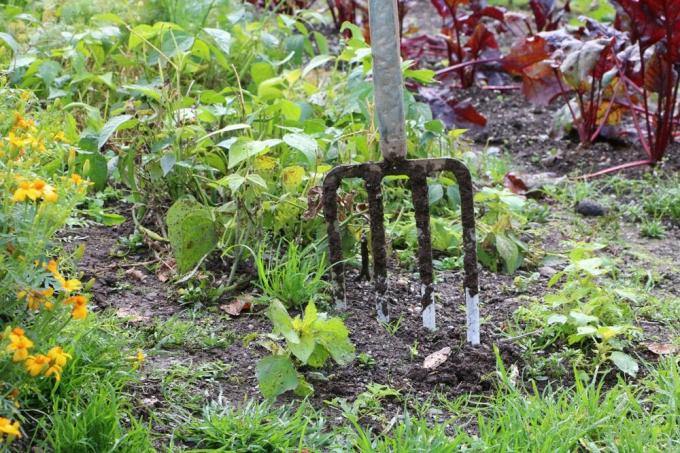

Table of contents
- Film for the longevity of raised beds
- Which slide should it be?
- PVC pond liner
- EPDM foil (rubber foil)
- bubble wrap
- Raised beds that can do without foil
- Conclusion
There are many reasons to purchase or build a raised bed, be it for reasons of space or because of unfavorable soil conditions, for the meaningful utilization of garden waste or from back-friendly Found. Another advantage of this form of vegetable cultivation is that the soil warms up much faster, so that it can be planted and harvested earlier. In order to do justice to all of this and to be able to achieve optimal yields, there are a few things to consider when building a raised bed. The film has a very special meaning.
Film for the longevity of raised beds
A raised bed should always be set up in a north-south orientation if possible, so that the sunlight can be optimally used. A prerequisite for the best possible thriving is the climate in the raised bed, which ideally is always slightly damp. It should not be able to escape too much moisture or even dry out the soil. It is precisely this moisture that can damage the respective sheathing if it is improperly constructed and can even damage the construction faster than expected. To counteract this, raised beds, especially those made of wood, are lined with foil, because wood that is permanently damp will not last long.
Which slide should it be?
Film that you want to use to line such beds should be resilient and robust, tight and tear-resistant and, what is particularly important, ecologically harmless. It should not only protect the wood from moisture and fungal infestation, but also the earth from the wood, because the wood is often treated with protective varnishes or varnished. been impregnated. Substances from these glazes could get into the soil and consequently into the vegetables. But even foil is not always completely harmless. PVC foils, EPDM foils (rubber foils) and knobbed foils are most commonly used to build raised beds.
PVC pond liner
Pond liners were originally intended to hold back large amounts of water, which is why they should be tear-resistant, flexible and durable as well as UV-stable. PVC foils are usually not as resilient as, for example, EPDM foils. They age relatively quickly, lose their flexibility and the plasticizers they contain can escape. This in turn causes the film to become porous and consequently leaky.
Films for raised beds should not only be stable, but above all plant-friendly and harmless to health. Right here lies the biggest mango of PVC sheeting. The high flexibility of these films is due to the plasticizers they contain. As everyone knows by now, plasticizers are harmful to humans and animals, and unfortunately no one can say to what extent these plasticizers affect both the soil and the crop. However, it must also be mentioned that hardly any film is completely free of any harmful substances.
EPDM foil (rubber foil)
The so-called EPDM foil is a bio-certified pond foil without any evaporation. Compared to a PVC film, however, this has other advantages with regard to raised beds:
- Very high tear resistance as well as elasticity and extensibility of up to 300%
- High flexibility, even at temperatures down to – 40 degrees
- Can be processed well at any time of the year
- Is durable, UV stable and ozone resistant
- Compatible with plants and microorganisms, environmentally neutral
Tip:
The biggest disadvantage is the plasticizers it contains. In addition, these foils are a bit more difficult to lay, but this is not a big deal given the usually small area of a raised bed.
bubble wrap

Another film that is used for raised beds is commercially available bubble wrap. As the name suggests, this film has many small bumps on one side while the other is smooth. The side with the nubs should always face the wood, as this is the only way to ensure optimal ventilation of the wood. But that is not the only advantage compared to other films.
- Bubble foil prevents direct contact between wood and soil
- Provides optimal protection against rotting and fungal attack
- Water can drain down between the knobs
- Is resistant to aging and chemicals
- It is pressure, tear, impact, wear and root resistant
- Is drinking water neutral and can be laid in any weather
- Usually contains no plasticizers
Tip:
An alternative to the foils mentioned is a raised bed fleece made of translucent (partially translucent) PET. It can be individually cut to size, protects against pests and separates the soil from the wood or soil. the respective border.
Raised beds that can do without foil
In addition to wood, commercial raised beds can also be made of aluminium, plastic or patina (corroded sheet steel). While foil is indispensable for raised beds made of wood, these materials can also do without, although the use of foil can still be advisable for aluminum and plastic. High-quality aluminum raised beds are corrosion-resistant, heat-insulating and heat-retaining, and maintenance-free. Plastic is relatively weatherproof, easy to set up, but quickly becomes stained and soft due to the lack of UV protection. These plastics often also contain plasticizers.
You can completely do without foil with raised beds patina, also known as Corten steel, a corroded sheet of steel with a rust patina. However, these raised beds lose material strength over the years. With a rusting through period of 15-20 years, the service life of these constructions is still significantly longer than that of wood.
Conclusion
Raised beds are generally a good thing. This allows optimal yields to be achieved in the smallest of areas. It can be harvested both earlier and longer, and problems with pests and weeds are limited. However, moisture can do a lot of damage if there is not enough protection, especially in wooden raised beds. Foil offers good protection. Consistent avoidance can significantly shorten the lifespan of wood in particular. However, for the sake of your own health, you should pay attention to environmentally friendly films.
 garden editorial
garden editorial I write about everything that interests me in my garden.
Learn more about creating a vegetable garden

Build your own raised bed out of stones: this is how it works
Building a raised bed out of stones is more complex than variants made out of wood or aerated concrete. On the other hand, they are very durable, decorative, offer decisive advantages and can even increase yields. We explain how it works here.

18 good neighbors of broccoli | mixed culture
Broccoli is a close relative of cauliflower and a great homegrown vegetable. In the vegetable garden, it is generally advisable to pay attention to good plant neighbors. A corresponding mixed culture has many advantages for all species involved.

Paths in the vegetable garden: 7 ideas for beautiful and practical bed paths
As a rule, there is no way in the vegetable garden without paths. Only through them can all beds be easily reached. Of course you have to think about how to create and design them. Here are some tips and ideas.

Creating a vegetable garden for beginners – instructions incl. plan
Quite a few people today dream of harvesting their own vegetables and being self-sufficient. No wonder: you know where it comes from and what's in it. You are also a bit more independent. Of course you need a garden for that. What is important when creating a vegetable garden is here.

Planning a vegetable garden - my first small self-sufficient garden
The vegetable garden is an important first step on the way to independent self-sufficiency. In order for your self-sufficient life to get off to a good start, it depends on the right planning, from A, for cultivation area, to Z, for fence. This step-by-step guide explains how to make your first small self-sufficient garden perfect.

Creating an organic garden - tips on plants, varieties and crop rotation
Pesticide-free and sustainable: There are many reasons for cultivating an organic garden. The near-natural landscapes also offer a protected retreat for endangered plant species. Creating an organic garden is easy to do. With the right preparation, it is possible to enjoy a bountiful bloom and harvest in the summer.



